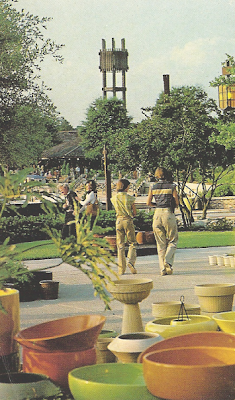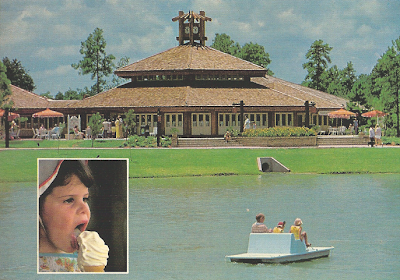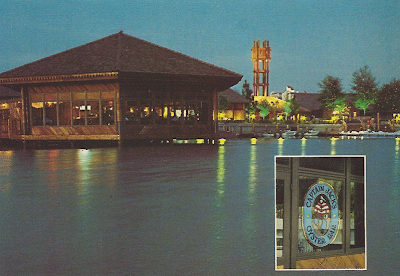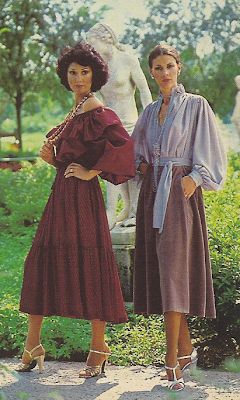 I'm proud to present something I've been working towards for many years: a near complete list of every shop or establishment to inhabit the Village, from 1975 to the present. It isn't fully complete, but is nearly so, and includes a map and even cute little pictures from the 1970's to show how cool the place was. I began to compile this for Widen Your World as part of my Walt Disney World Village section there. Each main structure in the Village is assigned a letter, and the tenants in each is listed underneath. I tried to organize each logically according to its' progression, although in some cases, each list is for a certain area of the building before moving on to the next.
I'm proud to present something I've been working towards for many years: a near complete list of every shop or establishment to inhabit the Village, from 1975 to the present. It isn't fully complete, but is nearly so, and includes a map and even cute little pictures from the 1970's to show how cool the place was. I began to compile this for Widen Your World as part of my Walt Disney World Village section there. Each main structure in the Village is assigned a letter, and the tenants in each is listed underneath. I tried to organize each logically according to its' progression, although in some cases, each list is for a certain area of the building before moving on to the next.
 Block A:
Block A:Crews Galley
Borden's Ice Cream Shoppe
EUROSPAIN - Arribas Brothers location
Sara Lee Bakery - Northern part, later became Ice Cream Parlor
Village Ice Cream Parlor - replaced Sara Lee Bakery
Donald's Dairy Dip - Expanded from Ice Cream Parlor, took over Pluto's Dog House
Verandah Restaurant - Sit down casual. Sandwiches, steaks
Minnie Mia’s Italian Eatery – first located here, moved to Block J
Pluto's Dog House - Hot dogs, snacks.
Christmas Chalet – Moved here during World of Disney construction.
Lego Imagination Center - Took over entire space circa 1996
Block B: (Later Demolished for World of Disney)
Chalet Candle Shop - possibly related to Main Street candle shop
China, Crystal & Silver - extension of Pottery Chalet
Flower Garden – merged into Pottery Chalet
Pottery Chalet - thrown clay demonstrations, subdivided into "shops", Taj Mahal music box
Anniversary Room – fine china
Buena Vista Interiors – gave way to Christmas Chalet
Christmas Chalet - later expanded to fill Pottery Chalet
Personal Message - Books & Stationary, relocated from 2R's
You and Me Kid - children's toys, clothes, activity area
Toys Fantastic - NOT Toys Fantastique. Mattel toys, Barbie dolls.
Guest Services / Photo Drop
Block C:
2 R's Read'n & Rite'n - later moved and became Personal Message
Great Southern Craft Company - relocated from Sector D, minus photo studio
Discover – same shop that earlier occupied Block I.
Basin Soap - specialty soaps, bath products
 Block D:
Block D:Lite Bite – soda, burgers, snacks
Lakeside Terrace - Lite Bite in all but name
Goofy’s Grill
Ghirardelli Chocolate
Block E:
Pipe Dreams – tobacconist, became Sachet In
Sachet In - scented sachets for baths, specialty soaps
Bath Parlor - towels & accessories
Toys Fantastic – Mattel toy outlet moved here when Block B was demolished
Summer Sands – Beachware, Florida fashions
Port of Entry - import gifts
Mickey's Character Shop
Team Mickey's Athletic Club - in vacated Character Shop space
Artespana – glass blowing and cutting, Arribas Bros locations
Toledo Arts – Gold inlaying, ring carving
EUROSPAIN – merged Arribas Bros. store, name through much of the 1990’s
Cristal Arts - Arriba Bros. location
The Village Art Gallery / Colonnade des Arts
Great Southern Craft Co. – large store, includes Photo Studio
Lillie Langtry's Photo Studio - old fashioned "Dress Up" photos
Studio M – character photos, airbrushed T-shirts and mugs
Guest Services - currently located in old Great Southern Craft Co. space
 Block F:
Block F:Van Otto’s Antiques
Sir Edward's Haberdasher – dress and casual menswear
Harrington Bay Clothiers
Block G:
Captain's Tower
Character Kid’s Tower – mid-90’s clothing, plush etc.
Disney's Pin Traders
Block H:
Coffee & Pastry Window
Candy Shoppe / Candy Factory
Village Character Shop – the original Mickey-branded location.
Pooh's Place
Gourmet Pantry - expanded and moved to fill entire building
Gourmet Pantry Deli - in the original Pantry space
Mickey's Pantry V.1 - rename of Gourmet Pantry with new paint, layout
Earl of Sandwich - replaced Deli half of Mickey's Pantry
Goofy's Candy Company - replaced other half of Mickey's Pantry
Mickey's Pantry V.2 - stocks some of the Disney at Home line
 Block I:
Block I:It's A Small World After All - children's clothes
Posh Pets – became Toys Fantastique when Toys Fantastique became Sassy’s (!)
Toys Fantastique - fancy & import toys, giant dollhouse, Pinocchio dioramas
Conched Out - Florida merchandise, sea shells
Board Stiff - surf merchandise, surf boards
Discover - nature & science themed toys
The City - "hip" clothing
Summer Sands – first location, “Florida” junk
Official All-Star Café Merchandise – short lived tie-in to Wide World of Sports
Pooh Corner
Disney Tails - Pet gifts and plush
Cane, Rattan, Wicker & Suns – decorative furniture
Crafty Corner – displaced potters, candle makers, etc from World of Disney construction.
Mickey's Greenhouse - small plants, fountains, garden gifts
Mickey's Mart - "bargain" basement, Replaced Greenhouse
Carolyns Couture – 1st location, replaced by Country Address
Country Address - female casual wear
Resortwear Unlimited - women's swimsuits, active wear
Disney at Home - home decor, bedding, kitchen items, candles, cook books
Goofy's Candy Company - replaced Disney at Home. Custom dipped candies
Block J:
Heidelberger's Deli
All-American Sandwich Shop
Minnie Mia's Italian Eatery – pizza, pasta. 2nd location.
Wolfgang Puck Express – replaced Minnie Mia’s.
Carolyn's Couture - designer fashions
Michael’s Barber Shop
The Flower Garden
Shoe Time
Footlights
Plus You – women’s accessories, later luggage and travel items
Signature Shop – engraving, personalized merchandise
Miss Merrily's Madness / Miss Merrily's Fashions – contemporary apparel
Toys Fantastique original location, moved across the way and became
Sassy's - pre-teen girl's sizes
Team Mickey's Athletic Club – replaced entire complex in 1990’s
Disney's 12 Days of Christmas – replaced Team Mickey’s
 Block K:
Block K:Village Post Office – relocated to old Welcome Center
Apothecary / Pharmacy – became Village Gifts & Sundries
Village Gifts & Sundries
Village Spirits
Village Cellar – subdivision of Village Spirits, in location of former Post Office
Country Address - moved from block I with same stuff when Resortwear Unlimited moved in
The Art of Disney
2Rs, Readin’ and Ritin’ – displaced here during early 90’s shuffle
The Wonderful World of Memories – scrapbooking supplies, photo frames, books
Disney’s Create A Tee – Hanes branded custom t-shirt location.
Block L:
Village Restaurant
Chef Mickey's
Rainforest Cafe
Village Lounge
Disney Cartoon Theatre - Village lounge with cartoons daily 5 - 10 pm
24KT Precious Adornments
Block M:
Windjammer Dock Shop - became waiting area for Captain Jack's
Captain Jack's Oyster Bar - expanded out into old waiting area
And a few more, somewhat more abstract comings, goings, and other items of note:
Opened as Lake Buena Vista Shopping Village in 1975
Name changed to Walt Disney World Village in 1977
Empress Lilly and Village Pavilion open in 1977
Name changes to Disney Village Marketplace in 1989
Village Playground in front of Lite Bite, replaced by
World’s Largest Perikaleidoscope in 1996, removed in 2006.
Pottery Chalet structure, part of Village Pavilion demolished in 1995.
Captain’s Tower Reflection Pond, removed in 1996 for Train Ride
Studio M – occupied McDonald’s building for a few years
Sports Tent – selling 1996 Olympic Games merchandise (!)
Sunset Cove / Margarita Bar – opened on the Marina in 1995
Mickey Fountains added in 1996
World of Disney opens in 1996
Dock Stage refurbished in 1996, 2008



